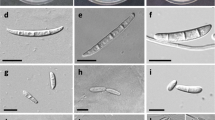Abstract
Plant species in the family Alismataceae are significant weeds of rice in Australia and South-East Asia. In Australia and Korea, parallel research programs have investigated the use of inundative biological control of these weeds using plant-pathogenic fungi. Recent studies have shown a close phylogenetic relationship between the organisms under investigation in the two countries. We surveyed Alismataceae weeds in southern South Korea for the presence of diseases that produced symptoms similar to those previously recorded in Australia and Korea. Fungal isolations were made from the diseased specimens. Phylogenetic studies of the relatedness of the isolates collected from Korea and Australia revealed that the isolates overlapped between those previously described in Korea as Plectosporium tabacinum and the newly named P. alismatis. Pathogenicity tests on Australian weeds (Alisma lanceolatum, Damasonium minus and Sagittaria graminae) were undertaken in the glasshouse. The host range testing showed that the isolates from Korea were less pathogenic on the Australian weeds tested than the Australian isolates. Therefore, although the isolates were phylogenetically related, the isolates from Korea did not show greater virulence or a wider or different host range than the Australian isolates.
Similar content being viewed by others
References
Chung YR, Koo SJ, Kim HT, Cho KY (1998) Potential of an indigenous fungus, Plectosporium tabacinum, as a mycoherbicide for control of arrowhead (Sagittaria trifolia). Plant Disease 82, 657–660. doi: 10.1094/PDIS.1998.82.6.657
Cliquet S, Ash GJ, Cother EJ (2004) Production of chlamydospores and conidia in submerged culture by Rhynchosporium alismatis, a mycoherbicide of Alismataceae in rice crops. Biocontrol Science and Technology 14, 801–810. doi: 10.1080/09583150410001720671
Cother EJ (1999) Host range studies of the mycoherbistat fungus Rhynchosporium alismatis. Australasian Plant Pathology 28, 149–155. doi: 10.1071/AP99025
Crump NS, Cother EJ, Ash GJ (1999) Clarifying the nomenclature in microbial weed control. Biocontrol Science and Technology 9, 89–97.
Felsenstein J (1985) Confidence limits on phylogenies: an approach using the bootstrap. Evolution 39, 783–791. doi: 10.2307/2408678
Fox KM, Cother EJ, Ash GJ (1999) Influence of infection of Rhyncosporium alismatis on seed production by rice paddy weed Damasonium minus (starfruit). Australasian Plant Pathology 28, 197–199. doi: 10.1071/AP99033
Graham RJ (1999) The biology and ecology of Damasonium minus (R.Br.) Buch — the first step in developing an IWM strategy for the control of herbicide resistant aquatic weeds of New South Wales rice crops. PhD thesis, Charles Sturt University, Wagga Wagga.
Hall TA (1999) BioEdit: a user-friendly biological sequence alignment editor and analysis program for Windows 95/98/NT. Nucleic Acids Symposium Series 41, 95–98.
Howlett BJ, Brownlee AG, Guest DI, Adcock GJ, McFadden GI (1992) The 5.8S ribosomal RNA gene is linked to large and small subunit ribosomal RNA genes in the oomycete Phytophthora vignae, P. cinnamomi, P. megasperma f. sp. glycinea and Saprolegnia ferax. Current Genetics 22, 455–461. doi: 10.1007/BF00326410
Jahromi F, van de Ven R, Cother EJ, Ash GJ (2006) The interaction between Plectosporium alismatis and sublethal doses of bensulfuronmethyl reduces the growth of starfruit (Damasonium minus) in rice. Biocontrol Science and Technology 16, 929–940. doi: 10.1080/ 09583150600828106
Jahromi FG, Cother EJ, Ash GJ (2002) Early infection process of Damasonium minus by the potential mycoherbistat Rhynchosporium alismatis. Canadian Journal of Plant Pathology 24, 1–6.
Jahromi FG, Ash GJ, Cother EJ (2004) Factors affecting disease development by Rhynchosporium alismatis in starfruit (Damasoniumminus), a weedof rice. Biocontrol Science and Technology 14, 281–290. doi: 10.1080/ 09583150410001665169
Lanoiselet V, Cother EJ, Ash GJ, van de Ven R (2001) Production, germination and infectivity of chlamydospores of Rhynchosporium alismatis. Mycological Research 105, 441–446. doi: 10.1017/ S0953756201003896
Perriere G, Gouy M (1996) WWW-Query: an on-line retrieval system for biological sequence banks. Biochimie 78, 364–369. doi: 10.1016/ 0300-9084(96)84768-7
Pitt WM, Goodwin SB, Ash GJ, Cother NJ, Cother EJ (2004a) Plectosporium alismatis comb. nov., a new placement for the Alismataceae pathogen Rhynchosporium alismatis. Mycological Research 108, 775–780. doi: 10.1017/S0953756204000541
Pitt WM, Cother EJ, Cother NJ, Ash GJ (2004b) Infection process of Plectosporium alismatis on host and non-host species in the Alismataceae. Mycological Research 108, 837–845. doi: 10.1017/ S0953756204000024
Thompson JD, Gibson TJ, Plewniak F, Jeanmougin F, Higgins DG (1997) The CLUSTAL X windows interface. Flexible strategies for multiple sequence alignment aided by quality analysis tools. Nucleic Acids Research 25, 4876–4882. doi: 10.1093/nar/25.24.4876
Author information
Authors and Affiliations
Rights and permissions
About this article
Cite this article
Ash, G.J., Chung, Y.R., McKenzie, C. et al. A phylogenetic and pathogenic comparison of potential biocontrol agents for weeds in the family Alismataceae from Australia and Korea. Australasian Plant Pathology 37, 402–405 (2008). https://doi.org/10.1071/AP08023
Received:
Accepted:
Issue Date:
DOI: https://doi.org/10.1071/AP08023




